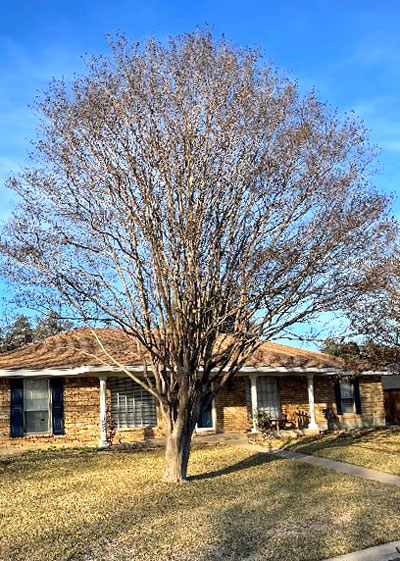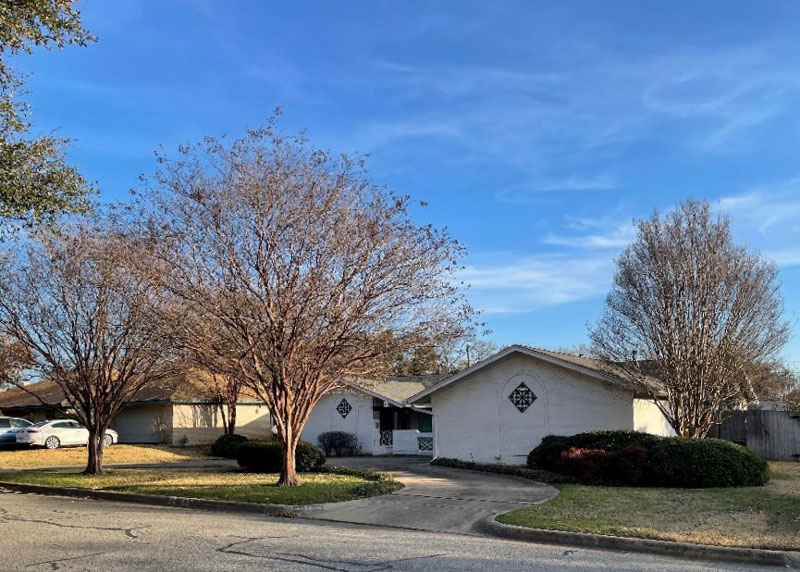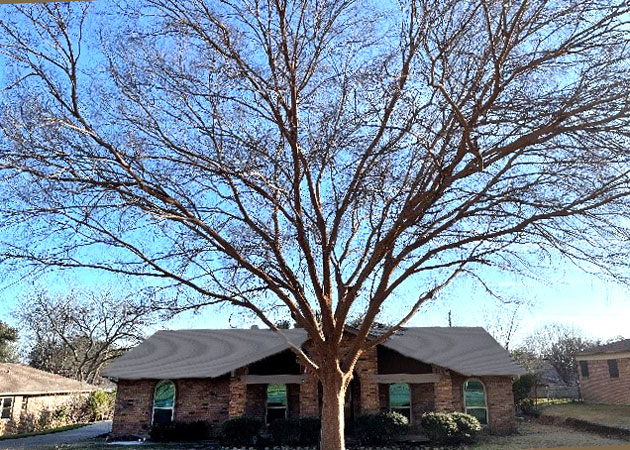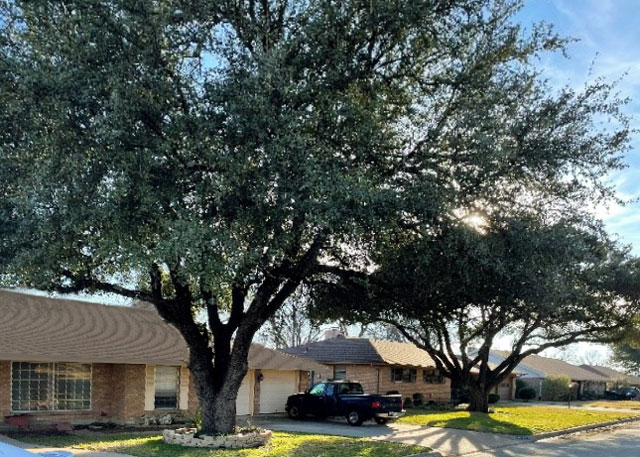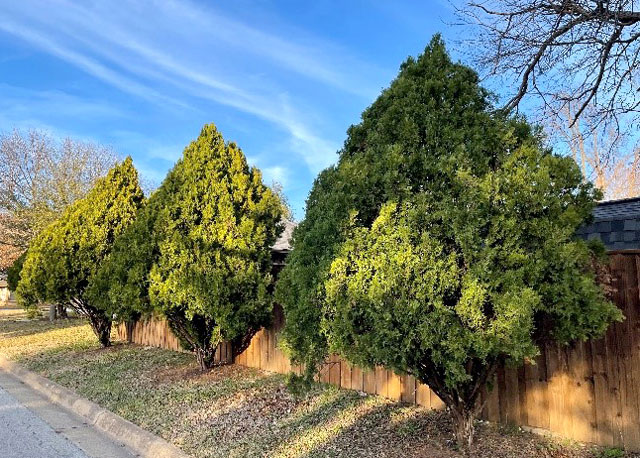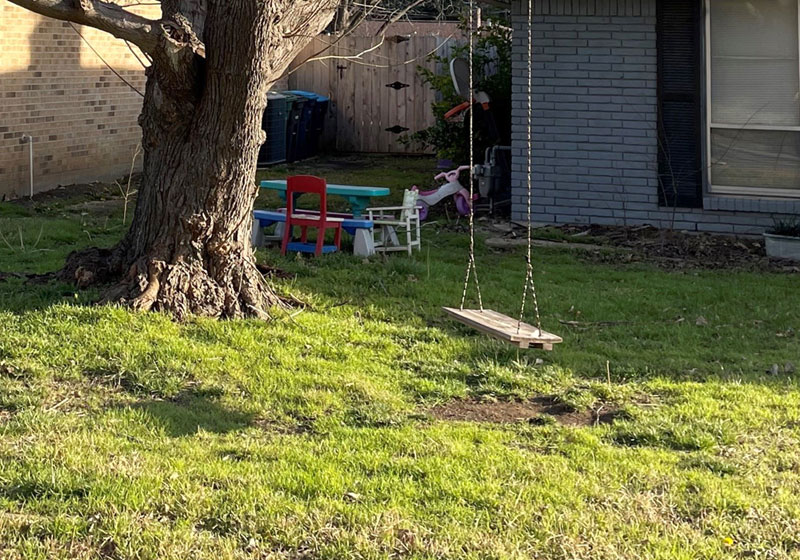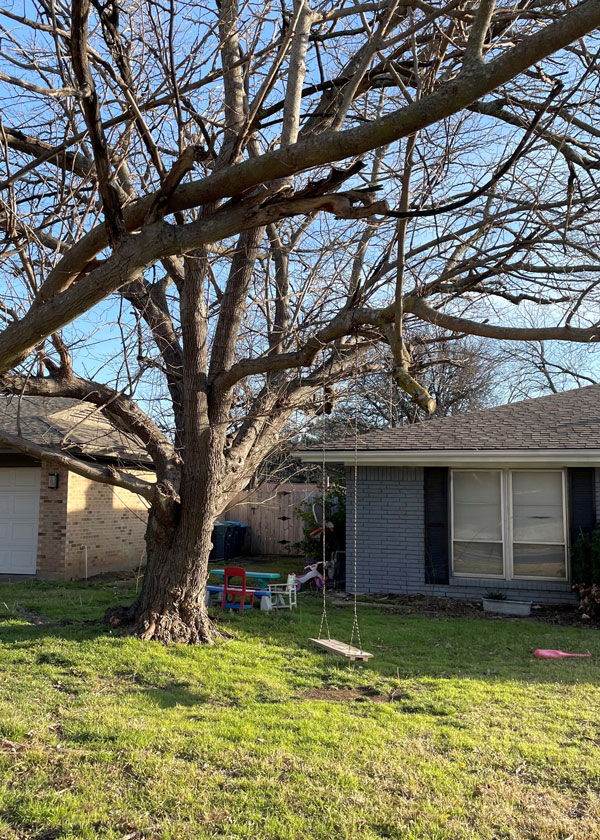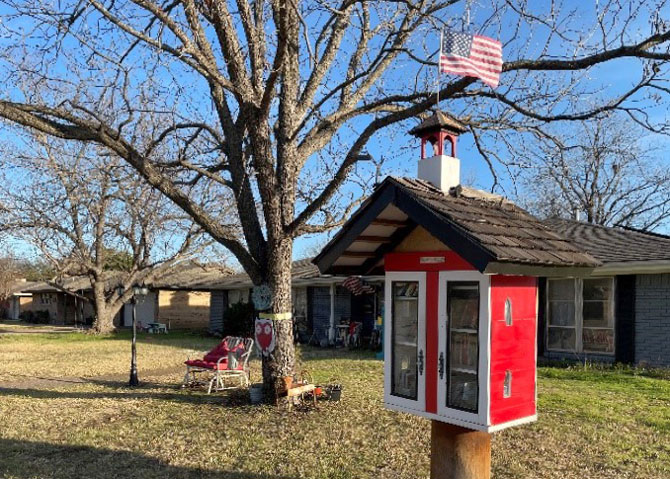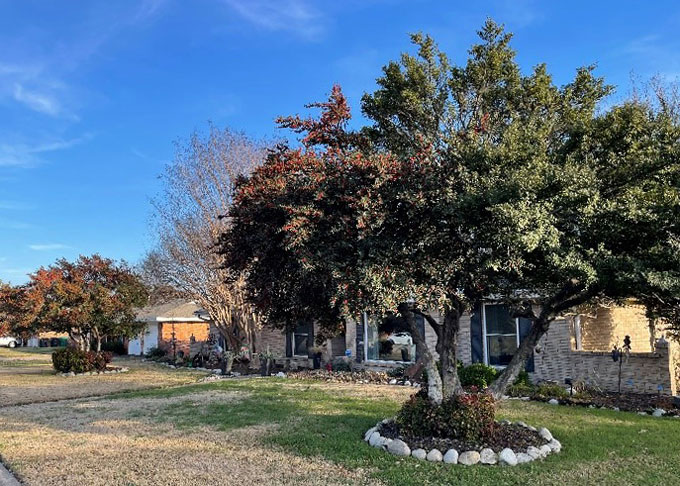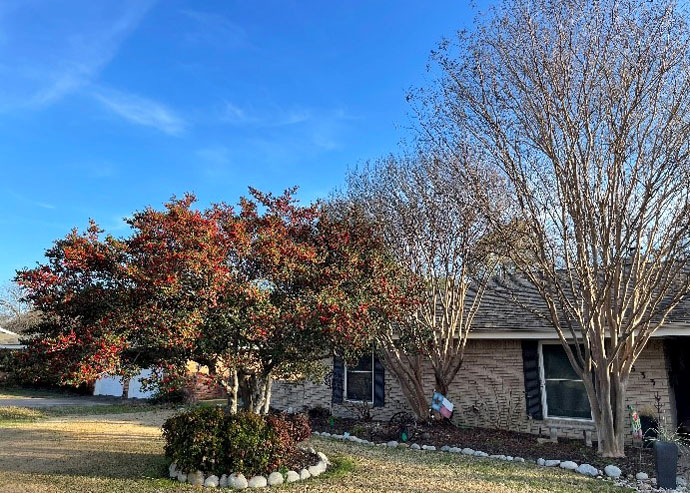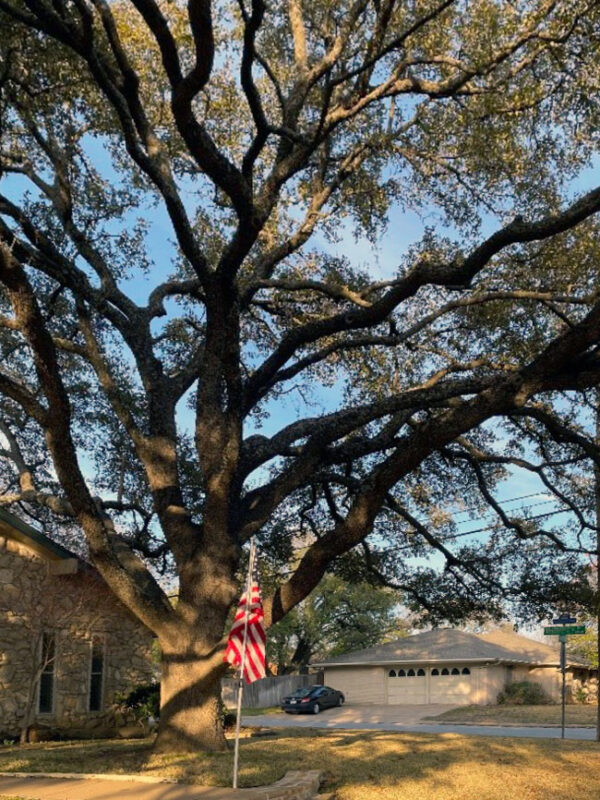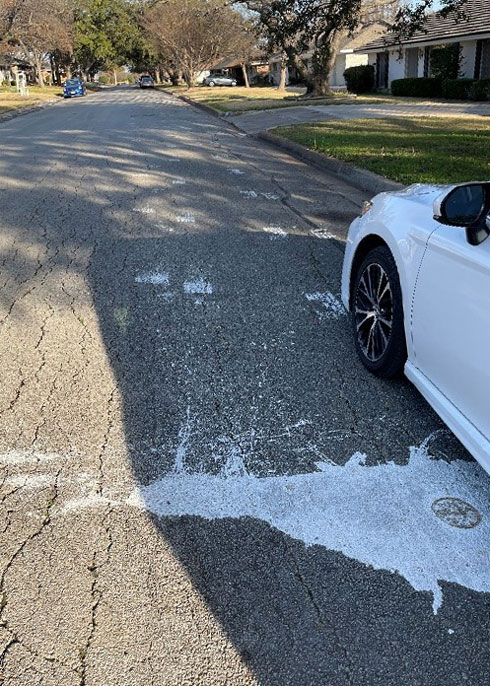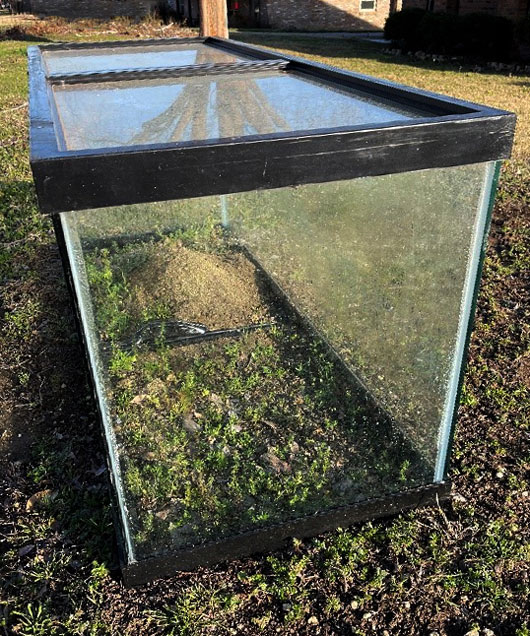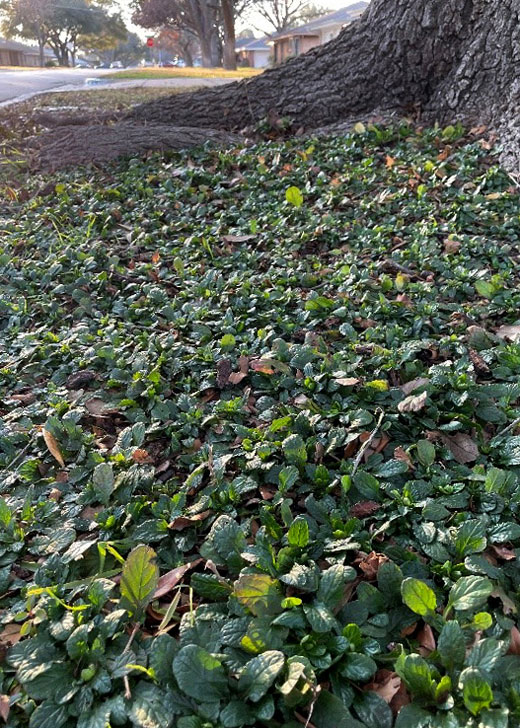Native Son: Lookin’ Up!
So I’m sauntering about the neighborhood streets, performing my constitutional (as Aunt Bea once did) while suffering in silence about the new glasses I got yesterday, the ones with the fancy “composite” lens. And by suffering in silence, I mean “being that crazy-looking old man dressed in a torn hoodie and cargo shorts, half-stumbling down the street in spite of a walking stick, smokin’ a stogie, and grumbling one moment, laughing out loud the next.” If anyone raises an eyebrow, I put my fingers to my ear, like I’m adjusting my earpiece … works every time.
You ready? Allons!
Photo above: Right off the bat … a Neil Sperry love story. I don’t know the cultivar, but this magnificent, 28+’ single trunk crape myrtle is magnificent primarily due to the beautiful natural form (branching structure) that has never been altered or crape-murdered.
Photo above: The House of Crape Myrtle Perfection! (Can you say, “M-m-mah-vel-ous!”) Also a good reminder of the benefits of educating yourself about gardening, as none of these show any signs/symptoms of improper pruning and Crape Myrtle Bark Scale, both of which are common in this area.
Seeing Through Benevolent Eyes…
Photo above: This lovely specimen of Lacebark Elm would complement the house better if it was planted to the side a bit, instead of straight in line with the front door. My mind conjures up a tale, now 25 years old, of an excited little girl picking the perfect spot for the young family’s new tree, and her loving father planting it right where she wanted.
Photo above: Live Oaks are often over-pruned, sometimes out of necessity (storms), sometimes to be safe (street/line clearance), sometimes to remove deadwood (Live Oaks produce a LOT of small dead branches), but primarily by folks who desire a sunny lawn beneath those branches. In this photo, the near tree is basically what an urban-sited, limbed-up (if you must) live oak should look like; the one behind it has been over-pruned a bit. Given time, the problems from over-pruning can lead to reduced vigor, insect/disease problems, even structural failure. My advice to you? Always use International Society of Arboriculture (ISA) certified arborists … and heed their advice to you.
Tale as old as time, Song as old as rhyme, Turfgrass and the Trees…
Curmudgeon’s Corner
I often hear people gritchin’ and moanin’ about Arborvitae … “Cemetery Plant!” they mock … “Old-fashioned!” they jeer … “Dated!” they scoff, unaware that the term “dated” is itself rapidly becoming just that …
Nay, I say! Are you people really dissing the literal “tree of life?” (arbor = tree; vitae = life) Life is hard! Texas is hot! Bagworms is mean! Eggs is expensive! Edukashuns is overratted! They sent Luka to LA!
Given a bit of water during future droughts, these Arborvitae will quite likely outlive everyone reading this little article, so let’s show some respect, people!
Photos above: I love looking at life through others’ lenses. Somewhere near here are some little kids who will one day remember this as the Big Swing under the Giant Tree at Mimi’s House, where life was grand every day. It really doesn’t take much for us to make a big difference in the life of others.
I should have known … the other side of the yard features a Little Library! Does your neighborhood have a cool Little Library?
Photo above: I love this set of mature Yaupon Hollies, playfully ringed with large cobbles. Interesting to note the male holly (no berries) at the right side of the photo – I remember back when many folks deliberately planted male yaupons among females to ensure good pollination and fruit set to ensure plenty of beautiful berries. I surmise, since these plants are likely 50 to 60+ years old, that’s the case here.
For years, I felt the practice was unnecessary, as there’s generally plenty of male yaupons in natural areas and gardens around town. Well, there is now, but 50 to 60 years ago, 100 years ago … not so much. Even I sometimes forget that yaupon hollies are not native to Fort Worth, so they were never just “around town” before people started planting them in gardens. Today, we realize that it’s not all about people … those adjacent male hollies ensure pollination is efficient and easy for the local bees, whether for these females or ones around the corner. Yeah, bees!
Photo above: The other twin bedecked in all her winter glory … until the Cedar Waxwings come through! Don’t you wish they’d give you some kind of sign when they’re coming, so you could watch? A flock of 50 could strip that sucker clean in, let’s say … hmmm … total fruit production divided by number of birds, minus the square root of the squared total canopy biomass, factor in variable winds S-SE 10-20 mph, add zip code, assume a pH of 8.1 and flux capacitor setting of 11, Venus in retrograde … exactly 22 minutes, 32.7 seconds!
… or thereabouts.
Finding a Spirit Tree
Photo above: Not sure there’s an official name for what I call “Spirit Trees,” but this is one. Maybe I’m hyper-sensitive or something, but I could feel this Live Oak from about 100 feet away, before I even saw it. Now I’m standing at the curb, looking up into the massive canopy for a few minutes before the husband comes out to see who in the Sam Hill is this curious gentleman outside whose presence is making his wife nervous. Apparently, the poor woman has never witnessed a full-blown Druid Tree Deification Ceremony, complete with the mature bull Musk Ox, before now. (Just kidding.) Hubs and I chat for a bit before I ask what he thinks of his incredible tree. I was not expecting, “It’s about to kill me … cleaning up all these leaves!”
Now that’s the spirit!
White Paint Mystery…
The white paint was spilled here has long since dried … but the mystery remains!
“Watson! Grab the scopes and my meerschaum! Let’s follow the tracks!
“Which we did … for precisely 22 minutes and 32.7 seconds, most of which I spent in repeated failed attempts at lighting that blasted meerschaum pipe … darn wind today…
“In the end … I, your humble servant Hemlock Holmes, have concluded that a wayward wind gust hit a wayward buzzard, forcing him to crash land. By matter of sheer luck, the flustered buzzard landed in an open bucket of paint that first-day employee, “Neon Leon,” left on the tailgate – and subsequently knocked said bucket of paint off said tailgate as the said flustered buzzard was extricating itself from the bucket just as the pick-up was leaving. When the truck finally stopped, the paint-laden buzzard hopped off the tailgate … and that’s as far as he got.”
My meercham released velvetry ribbons that danced in the sunshafts. “Elementary, my good friends. Hmmm … over there. Seems that yonder migrating flock of two score and ten passerines is voraciously consuming a small mott of Ilex vomitoria … indeed.
Above photo: Fire ants are smart. This colony found a warm tropical paradise beneath a discarded aquarium.
Above photo: Upon arriving back home, I find the rogue patch of Ajuga clustered at the base of a tree is doing splendidly. Obviously, I did not plant it, as I have managed to kill every single Ajuga I ever planted. Same goes for Italian Cypress. Too much, too little, too early, too late, too wet, too dry, too whatever … I killed them all. I’m not proud of that; I just want you to know that I know that sometimes stuff just doesn’t work out, no matter what you do. Maybe the secret to gardening success is focusing on what went right, not what went wrong. Who knows … even I may yet one day be crowned, “That Ajuga Guy!”
But probably not.
______________________________________________________________
Loads of learning goin’ on all over place this spring … check your local public garden for educational classes / seminars. I thought the Grow @ Clark Gardens series looked pretty good … check it out at their website for more information.
I need a road trip! Let me know if you’d like me to come and speak to your group sometime. I’m low maintenance, flexible, and you know I like to go just about anywhere. No city too big; no town too small. Just send me an e-mail at stevenchamblee@yahoo.com and we’ll work something out.

